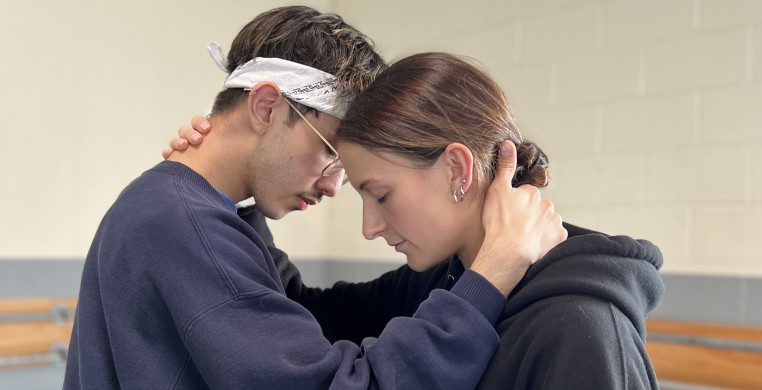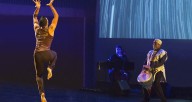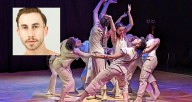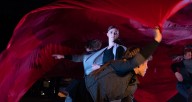Have you ever watched a dance performance and wondered how the dancers learned the steps? Maybe you were curious about what inspired the piece? Cerqua Rivera Dance Theatre (CRDT) pulls back the curtain in their recurring Inside/Out performance series. The company performs works in progress, gives a glimpse into the rehearsal process, and allows for the audience to input their own ideas and observations.
March 29th, at the Garage at Dovetail Studios, CRDT unveiled a new work by resident choreographer Katlin Bourgeois (they/them), "Tether." After presenting the work, Bourgeois demonstrated what the creation process was like with two members of the company, and then described the inspiration of the piece and how they personally connected to the theme.
Bourgeois was inspired by a story about a local art teacher and the connection to their student, told at "Stories From The West Side," an event hosted by CRDT and violinist James Sanders. The relationship between student and teacher struck a chord with them, and a duet exploring this communion was born.
At Inside/Out, a casual affair, the company presented the duet in two versions. Version one featured dancers Bruno Salgado and Catie Armbrecht, while the second iteration was danced by Brennen Renteria and Bennett Cullen. There was a striking difference between the two performances, not just in the physical identities of the performers, but also in their connection to each other and how that was reflected through movement.
The first duet, male/female, had a tenderness that was embodied through the ebb and flow of shared weight. Seamless transitions into the floor and tender lifts up into the air demonstrated how the give and take between partners is built on trust and a mutual intuition of their bodies in both space and time. As the dancers rode the wave of violinist Felipe Tobar's melody, it was clear that their energy bound them together, even when separated on the dance floor.
The second version differed from the first in that it was two males, but also in the quality of their movements and how this affected the type of relationship conveyed. Rather than finding a symbiotic connection through the choreography, this iteration had a more combative aura. Each grasp felt like a struggle for power, lifts creating moments of tension rather than comfort.
What was most interesting about the work was that in the end one dancer leaves the stage as the other stays, effectively breaking the relationship that we have witnessed evolve. Although the dancer withdraws from the space, does the relationship dissolve, or is the departure only corporeal? In speaking with the audience, Bourgeois gives two examples of student-to-teacher relationships that demonstrate how impactful these connections can be.
Interestingly, each story seemed to correlate to the tone of the individual duet. Their first relationship was described as nurturing and uplifting, while the second relationship, although inspiring, was rough around the edges and not always received by a young Bourgeois in the same way.
As Bourgeois takes the floor to shift into "creation mode" there is a childlike nervousness that is palpable in the audience. They introduce the two dancers who will be demonstrating the process of creating the choreography, and as the band strikes up an improvisational score, Bourgeois begins to position the players, like chess pieces on a board. Standing outside of the kinesphere of the dancers, they verbally instruct the dancers in how to move, the beginnings of a conversation between Bourgeois and the bodies on the floor.
This simulation of the rehearsal process, its own performative act, shifts into a more natural flow as Bourgeois jumps into the role of one of the dancer's to demonstrate a movement. The execution of the idea releases them from the tension of showcasing what is often an intimate process between choreographer and their dancers. The continuation of the staged rehearsal shifts into a relaxed ambience and Bourgeois' confidence in composing human bodies together is apparent.
"Tether" will be premiering at the Cerqua Rivera Dance Theatre Spring Concert, where the company will be celebrating its 25th-year anniversary. Performances will be held at the Ruth Page Center for the Arts May 17th-19th. Tickets are available at the link below.




